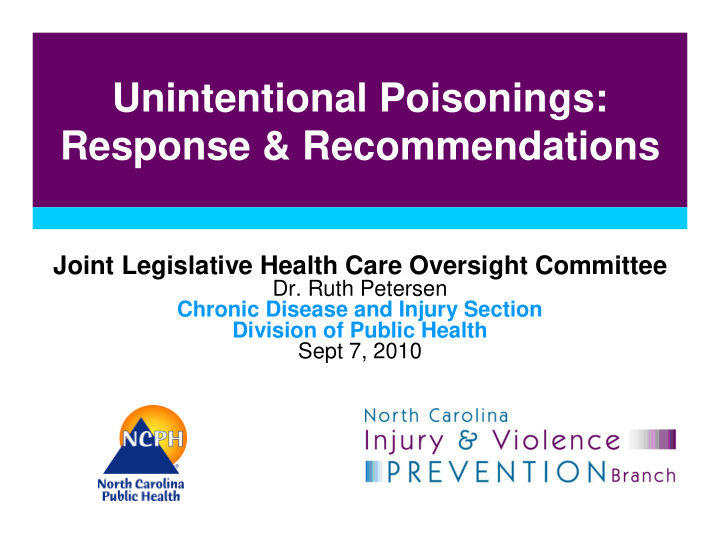



Unintentional Poisonings: Response & Recommendations Joint Legislative Health Care Oversight Committee Dr. Ruth Petersen Chronic Disease and Injury Section Division of Public Health Sept 7, 2010
Historical DPH Response • 2000-01: DPH sees increases in unintentional poisoning deaths • 2002: NC asks CDC for 1 st Epi-Aid Team to address issue • 2003-2004: As result of Epi-Aid Team, Joint Task Force convened to make recommendations
Task Force Report 2004 Groups included: SBI, DEA, DPH, Substance Abuse, Justice, Medical Examiner’s Office 43 recommendations: Leadership, Surveillance, Law Enforcement, Legislative, Education, Clinical Interventions Controlled Substance Reporting System (CSRS)- NC PMP
Ongoing Efforts Since 2005 • 3 County study to assess circumstances around deaths – Data from CSRS, law enforcement, VR, ME – Wilkes, New Hanover, Durham • NC Detect and ED data • Community/County- Promising Projects • Continued NC evaluation (Burden document)
Burden of Poisoning Report (2009) www.injuryfreenc.ncdhhs.gov/DataSurveillance/PoisoningBurden.pdf
State Response Since 2005 • Narcotics Task Force (Medicaid) • CSRS (July 2007) • Statewide Strategic Plan- Injury/Violence Prevention – Poisoning is top priority • SBI – Dedicated staff unit • Medical Examiner’s Office • Governor’s Institute on Alcohol and Substance Abuse • Carolina Poison Center – Informs public on hazards of prescription medications • SafeKids NC – Medication Drop Off with 1.4 million morphine equivalent doses • NC IOM Healthy NC plan
Future Work to Address Issue • Increase DPH surveillance activities • Provide overall coordination between all on- going efforts with leadership commitment and clarification of roles and responsibilities • Identify funding opportunities for evaluating pilot project effectiveness and spreading interventions that work
Promising Projects • Safer Opioid Prescribing Initiative (2008); funding from Governor’s Institute (GI), Division of MHDDSAS, KBR • Over 20 regional educational events (focus on Eastern Counties) for prescribers of controlled substance (on-going since 2009) • Emphasis on CCNC Networks and FQHC • Local resources identified, TA and clinical tools provided to practices, with patient handouts; instruction about safe patient storage and disposal
Billboards Trainings Newspaper Ads Drug Turn In Events Community Collaboration
Promising Projects • Other initiatives to integrate substance abuse identification and treatment in primary care: • Center of Excellence for Integrated Care-3 year funding from HWTF and DMA • CCNC expanding Safer Opioid Prescribing Initiative • KBR awarded 16 grants to governmental and nonprofit organizations in NC to integrate substance abuse into primary care medical homes
Project Lazarus • Innovative community intervention focused on avoiding and responding to opioid overdose; includes provision of naloxone (opioid overdose antidote) • Wilkes County has taken the lead, but effort across NC, the Cherokee Reservation, and Fort Bragg • Training for •medical providers (identifying at-risk patients, naloxone), •patients and their family or peers (plan, recognize and respond to overdose) including a free overdose rescue kit
Lessons Shared Between States • NC Task Force is a model • Ohio Prescription Drug Abuse Task Force – $500K social marketing campaign, links to policy and providers • Washington- – “Take as Directed” campaign and stronger provider guidelines • NM- Good Samaritan law – Immunity to those needing medical assistance for illegal use • KY- – Interstate data sharing from prescription monitoring system • WV- – Evaluation of connections between misuse, abuse and diversion • Maine- – Safe Medication Disposal
Moving Forward Enhancements to CSRS can increase value to agencies across the state – Photo ID requirement – Allow Physician-Designee Accounts for clinical practices – Change penalty for misuse of data – Require all physicians dispensing drugs to report to CSRS – Adopt interstate data sharing agreement
Moving Forward • Supporting licensing and training of Pain Clinics who dispense controlled substances • Support requirement to create prescribing guidelines for controlled substances • Support ‘Good Samaritan’ law offering limited liability for medical emergency reporting and use of naloxone
In 2009, NC had over a 1,000 deaths from unintentional poisonings, second only to motor vehicle crashes in the area of injury death
Recommend
More recommend